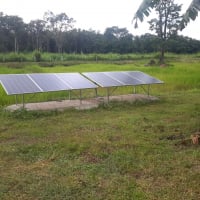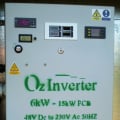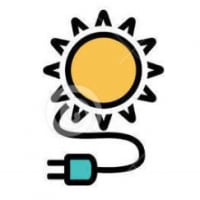GE washing machine won't run off inverter power
fredb
Registered Users Posts: 11 ✭✭
Sorry if this issue was discussed in another thread, I searched and did not find one though.
I have a 4.5kw off grid soar power system from wholesale solar. Dual magna sine inverters. 48 volt system. 860 Ah capacity. 12kw winco backup genset.
Ive been running the whole house on the system for several months. TV, satellite receivers, computers, gas dryer, gas range (having some built in electronics)- all work fine. The lights dim slightly when the electric fridge or well pump comes on but not a problem.
I just tried using a new electric washer for the first time It has all the latest load sensing and other features I would prefer to not have. It won't work on inverter power. Works fine when running off a honda 2000 watt genny or when i have the big genny running.
I returned the first washer to the store thinking it was defective however when the second one failed too, I began to suspect my power supply.
Inverter power has 123-124 volts measured at the outlet. frequency I don't know.
Anyone else have issues with newer type washers on inverter power?
What type of 110v washers are you using successfully with your inverter power?
Thanks for any help!!
I have a 4.5kw off grid soar power system from wholesale solar. Dual magna sine inverters. 48 volt system. 860 Ah capacity. 12kw winco backup genset.
Ive been running the whole house on the system for several months. TV, satellite receivers, computers, gas dryer, gas range (having some built in electronics)- all work fine. The lights dim slightly when the electric fridge or well pump comes on but not a problem.
I just tried using a new electric washer for the first time It has all the latest load sensing and other features I would prefer to not have. It won't work on inverter power. Works fine when running off a honda 2000 watt genny or when i have the big genny running.
I returned the first washer to the store thinking it was defective however when the second one failed too, I began to suspect my power supply.
Inverter power has 123-124 volts measured at the outlet. frequency I don't know.
Anyone else have issues with newer type washers on inverter power?
What type of 110v washers are you using successfully with your inverter power?
Thanks for any help!!
Comments
-
Can you elaborate a little on what the symptoms are, for example attempts to start then shuts down or the inverter shuts down or goes into fault , this would be helpful. Have you measured voltage sag on both AC and DC of the inverter?1500W, 6× Schutten 250W Poly panels , Schneider MPPT 60 150 CC, Schneider SW 2524 inverter, 400Ah LFP 24V nominal battery with Battery Bodyguard BMS
Second system 1890W 3 × 300W No name brand poly, 3×330 Sunsolar Poly panels, Morningstar TS 60 PWM controller, no name 2000W inverter 400Ah LFP 24V nominal battery with Daly BMS, used for water pumping and day time air conditioning.
5Kw Yanmar clone single cylinder air cooled diesel generator for rare emergency charging and welding. -
Sure- the washer will jump to the end of the cycle at some point in the cycle. Sometimes right when it starts and sometimes after filling the tub.
I have not measured any voltage drops. I will try that with my multimeter. It may or may not be fast enough to detect a very short lived drop. -
I wonder if there's a built-in GFCI in the washer? Maybe check the manual specs?Off-grid.
Main system ~4kw panels into 2xMNClassic150 370ah 48v bank 2xOutback 3548 inverter 120v + 240v autotransformer
Night system ~1kw panels into 1xMNClassic150 700ah 12v bank morningstar 300w inverter -
The current is usually as good or better than the grid. So as others have said check for voltage sag due to too small of wiring to the battery bank, or some other anomaly, not running other items at the same time and the inverter going into energy saver mode when filling with water and having a very minimal draw... Something odd like that will likely be the cultrate.
I've run a couple different simple washing machines off my small 1800 watt ProSine inverter with no problem. Current one is a 20+ year old front loader by Whirlpool(I think)
Home system 4000 watt (Evergreen) array standing, with 2 Midnite Classic Lites, Midnite E-panel, Magnum MS4024, Prosine 1800(now backup) and Exeltech 1100(former backup...lol), 660 ah 24v Forklift battery(now 10 years old). Off grid for 20 years (if I include 8 months on a bicycle).
- Assorted other systems, pieces and to many panels in the closet to not do more projects. -
I cannot figure out a reason why you are having issues (battery bank, hardware+AC+DC wiring is OK, runs on eu2000i just fine) other loads, some (minor?) light flickering.
Do you notice lights getting "brighter" (or possibly dimmer) when a 120 VAC load goes on? A problem with a "bad" neutral wire/connection and 120/240 VAC split phase systems (standard North American residential power). On a 120 L1 to neutral load, a bad connection will cause a voltage drop on L1 (say to 80 VAC for your washer). That causes a voltage rise (upwards ~160 VAC) on L2 to Neutral for your lights (depending on how your home is wired). And any L1-L2 240 VAC loads are just fine.
-Bill
Near San Francisco California: 3.5kWatt Grid Tied Solar power system+small backup genset -
I suspect an older washer would work fine. Seems to be the new fangled ones with the load sensing module that is reacting poorly to whatever my issue is.
Yes, I do get some dimming of lights and a momentary decrease in woodstove blower speed when the fridge (120vac) kicks on or when the well pump (240vac) kicks on.
My inverter/equipment is in a shed about 125 feet from the house. The service wires to the house are way oversized. I think it was 100 amp wire per leg. I did use aluminum service wire and used conductive "grease" on the aluminum wire at terminal connections, being careful to separate the strands and apply the grease to each strand.
Maybe I could monitor the voltages on each leg at the inverter panel display and have my wife open the fridge door to get the fridge to run and then see what the voltages do.
I think I will also redo the neutral connections on the service wire.
No one else having any trouble with modern washers? -
I have a 3 year old LG WT4870CT washer with all the bells and whistles including load balancing and it works fine on my Outback Radian GS4048A inverter.
Rick4480W PV, MNE175DR-TR, MN Classic 150, Outback Radian GS4048A, Mate3, 51.2V 360AH nominal LiFePO4, Kohler Pro 5.2E genset. -
frontload washer dryer pair, 120VAC no issues on the inverter
Powerfab top of pole PV mount | Listeroid 6/1 w/st5 gen head | XW6048 inverter/chgr | Iota 48V/15A charger | Morningstar 60A MPPT | 48V, 800A NiFe Battery (in series)| 15, Evergreen 205w "12V" PV array on pole | Midnight ePanel | Grundfos 10 SO5-9 with 3 wire Franklin Electric motor (1/2hp 240V 1ph ) on a timer for 3 hr noontime run - Runs off PV ||
|| Midnight Classic 200 | 10, Evergreen 200w in a 160VOC array ||
|| VEC1093 12V Charger | Maha C401 aa/aaa Charger | SureSine | Sunsaver MPPT 15A
solar: http://tinyurl.com/LMR-Solar
gen: http://tinyurl.com/LMR-Lister , -
Aluminum has a tendency to displace under screw terminals over time, good idea is to re torque after initial installation just to be sure.1500W, 6× Schutten 250W Poly panels , Schneider MPPT 60 150 CC, Schneider SW 2524 inverter, 400Ah LFP 24V nominal battery with Battery Bodyguard BMS
Second system 1890W 3 × 300W No name brand poly, 3×330 Sunsolar Poly panels, Morningstar TS 60 PWM controller, no name 2000W inverter 400Ah LFP 24V nominal battery with Daly BMS, used for water pumping and day time air conditioning.
5Kw Yanmar clone single cylinder air cooled diesel generator for rare emergency charging and welding. -
Thanks for all of the replies. I am going to try to run it straight off the inverter which will isolate the issue to either the inverter or my service wire/house wiring.
-
Good idea, was going to suggest doing that, there should be no reason why a quality inverter would have a problem with a modern washer.
1500W, 6× Schutten 250W Poly panels , Schneider MPPT 60 150 CC, Schneider SW 2524 inverter, 400Ah LFP 24V nominal battery with Battery Bodyguard BMS
Second system 1890W 3 × 300W No name brand poly, 3×330 Sunsolar Poly panels, Morningstar TS 60 PWM controller, no name 2000W inverter 400Ah LFP 24V nominal battery with Daly BMS, used for water pumping and day time air conditioning.
5Kw Yanmar clone single cylinder air cooled diesel generator for rare emergency charging and welding. -
You can also try a second test too, running a 100 Watt filament lamp or a small electric heater too in parallel with the washer--This is a common test with generators to see if the extra load "stabilizes" the voltage/frequency output of the genset (lightly loaded gensets can have the wrong frequency or voltage output near zero loads).
-Bill
Near San Francisco California: 3.5kWatt Grid Tied Solar power system+small backup genset -
Head scratching problem it seems. You have already considered the "usual suspects". I may also look at the power supply where the washing machine is located. Loose connection on the outlet etc? Overloaded circuit?First Bank:16 180 watt Grape Solar with FM80 controller and 3648 Inverter....Fullriver 8D AGM solar batteries. Second Bank/MacGyver Special: 10 165(?) watt BP Solar with Renogy MPPT 40A controller/ and Xantrex C-35 PWM controller/ and Morningstar PWM controller...Cotek 24V PSW inverter....forklift and diesel locomotive batteries
-
May not be applicable here, but I've occasionally had such wierdness happen with my inverters going into search mode unexpectedly. If the machine was just counting down a timer or waiting to fill, and no other loads running, maybe the inverters went into a search cycle, with the first pulse causing the machine to wake up and start drawing enough to keep inverters awake, but having lost track of the wash cycle in the process?
Just another thought to toss into the mix.Off-grid.
Main system ~4kw panels into 2xMNClassic150 370ah 48v bank 2xOutback 3548 inverter 120v + 240v autotransformer
Night system ~1kw panels into 1xMNClassic150 700ah 12v bank morningstar 300w inverter -
This may explain it...
http://mvvikingstar.blogspot.com/2013/03/summery-and-conclusion-compatibility.html
-
Wow. I can see my well pump has a lousy PF, but that was an influencing factor to get the inverter I did (xw6048) It's got terrific PF capacity and leg imbalance (one 120V leg being heavily loaded, and the other not). I never wanted to have to explain to SWMBO why the blow dryer wouldn't work.
The following link has an extensive report about poor power factor loads and how they affect generators. I have 2 backup generators, both same HP, but one has an old style gen head, that laughs at low PF, the other can barely run the pump without the pump protector tripping offline from insufficient power.
http://www.screenlightandgrip.com/html/emailnewsletter_generators.html
Powerfab top of pole PV mount | Listeroid 6/1 w/st5 gen head | XW6048 inverter/chgr | Iota 48V/15A charger | Morningstar 60A MPPT | 48V, 800A NiFe Battery (in series)| 15, Evergreen 205w "12V" PV array on pole | Midnight ePanel | Grundfos 10 SO5-9 with 3 wire Franklin Electric motor (1/2hp 240V 1ph ) on a timer for 3 hr noontime run - Runs off PV ||
|| Midnight Classic 200 | 10, Evergreen 200w in a 160VOC array ||
|| VEC1093 12V Charger | Maha C401 aa/aaa Charger | SureSine | Sunsaver MPPT 15A
solar: http://tinyurl.com/LMR-Solar
gen: http://tinyurl.com/LMR-Lister , -
Looks like a very reasonable finding.
BillNear San Francisco California: 3.5kWatt Grid Tied Solar power system+small backup genset -
Yes, some modern domestic appliances seem to be really mean/cheap skates on their internal power supplies buffers.
On the OzInverter we have had to add 2 parallel Motor Run Caps on the Control board PCB, AC CT input, to elevate issues.
Everything is possible, just give me Time.
The OzInverter man. Normandy France.
3off Hugh P's 3.7m dia wind turbines, (12 years running). ... 5kW PV on 3 Trackers, (8 years) .... 14kW PV AC coupled using Used/second hand GTI's, on my OzInverter created Grid, and back charging with the AC Coupling and OzInverter to my 48v 1300ah batteries.
-
Posted several years ago about solving our HVAC problem with our old Trace equipment.Ranch Off Grid System & Custom Home: 2 x pair stacked Schneider XW 5548+ Plus inverters (4), 2 x Schneider MPPT 80-600 Charge Controllers, 2 Xanbus AGS Generator Start and Air Extraction System Controllers, 64 Trojan L16 REB 6v 375 AH Flooded Cel Batteries w/Water Miser Caps, 44 x 185 Sharp Solar Panels, Cummins Onan RS20 KW Propane Water Cooled Genset, ICF Custom House Construction, all appliances, Central A/C, 2 x High Efficiency Variable Speed three ton Central A/C 220v compressors, 2 x Propane furnaces, 2 x Variable Speed Air Handlers, 2 x HD WiFi HVAC Zoned System Controllers
-
There have been a few complaints about Magnum AC inverters and problems with regulation during load changes--But not that often.
Adding a motor run capacitor is a common solution for fixing power factor issues with induction motors. Adding a capacitor in parallel with an induction motor is a "perfect" fix (from an electrical engineering point of few). However, the capacitor should be in parallel with the motor (switched on and off with the motor), and the size/value of the capacitor selected to match the motor's inductor value and correct the power factor to ~0.95 maximum (if corrected to 1.00 or "positive" with the capacitor, the motor+capacitor can become unstable when the motor is shut down--The capacitor can turn the motor into a genset and cause dangerous voltages as the motor coasts to a stop).
With "electronic loads" like a washing machine with a VFD (variable frequency drive), the current waveform is no longer "linear" and adding a parallel capacitor does not "fix" this type of "poor power factor" issue (the current flow does not "lag" the voltage sine wave nicely, it depends on the "front end" of the VFD/electronic power supply and operating conditions of the motor+VFD).
I would be careful with adding a motor run capacitor in parallel with a washing machine to fix the problem. Without th proper test equipment and a selection of capacitor sizes, this is a real shot in the dark if this will fix the problem or cause other problems (inverters do not like driving inductive or capacitive loads).
-Bill
Near San Francisco California: 3.5kWatt Grid Tied Solar power system+small backup genset -
Is this really a "new" washer? I mean one with an electronic drive?
-
I still have a chance to return this washer (GE model GTW460ASJ7WW). I would return it if I was certain there is another model available that does not have this problem.
Anyone using magnum inverters and a fairly new washer? What model? -
Thanks for the good advice. I am going to call GE and try to determine if it is a VFD motor.
-
At my last house, I was able to run my GE washing machine from an 1800W Xantrex inverter with no issues. http://www.alpharubicon.com/altenergy/altwashclothes2manytoyz.htm
I have a larger setup at my current home, and front loader washer and dryer. I need to repeat the test, but expect it to work even better. These have a soft start on the motors, unlike the older one.
Good luck on your problem. These gremlins can be very frustrating. I finally removed the GFCI from my inverter. Just about any electrical motor would cause it to trip.
-
Problem solved!
I found a place that sells a motor run capacitor mounted in an enclosure. I bought that and connected a power cord to the wires inside using wire nuts. I mounted the box on the wall behind the washer and plugged the power cord into the same outlet as the washer. I leave it plugged in all of the time and have had no issues. It has fixed the problem I was having.
The unit is called a powersaver 1200 and it is marketed as a power saving device when used near inductive motors. Note that the capacitor will hold a charge for a short time after unplugging the cord so caution should be used. (Do not touch the cord prongs). The device has an indicator light that is green when power is present. The light will discharge the unit to a safe voltage in a couple of minutes after the power cord is unplugged. -
Note: The Power Saver 1200 does not same money on your electric bill for normal residential installations (home meters do not, generally, charge for "out of phase power").
However, when you connect one of these to your off grid inverter--You are causing some extra energy losses for the inverter. I suggest that you want to "turn off" the Power Saver when the washer is not being used.
If you have a larger off grid system that runs 24x7 anyway--Turning off the Power Saver may not make much difference in overall battery power usage.
-Bill
Near San Francisco California: 3.5kWatt Grid Tied Solar power system+small backup genset -
How would something like this PowerSaver 1200 work for lights that dim when a 1/2 HP 240v pump or 120v fridge come on? I have Light flicker at the start of those devices on my Conext SW 4024 split phase inverter (about 1700W continuous on each leg). The rest of my loads are very low - less than 300 watts. If it would help, would it have to be on the same branch circuit as the Pump or Fridge? that would require 2 Power Savers as they are on different circuits.
REC TwinPeak 2 285W 3S-3P 2.6kW-STC / 1.9kW-NMOT Array / MN Solar Classic 150 / 2017 Conext SW 4024 Inverter latest firmware / OB PSX-240 Autotransfomer for load balancing / Trojan L16H-AC 435Ah bank 4S connected to Inverter with 7' of 4/0 cable / 24 volt system / Grid-Assist or Backup Solar Generator System Powering 3200Whs Daily / System went Online Oct 2017 / System, Pics and Discussion
Categories
- All Categories
- 233 Forum & Website
- 141 Solar Forum News and Announcements
- 1.4K Solar News, Reviews, & Product Announcements
- 199 Solar Information links & sources, event announcements
- 899 Solar Product Reviews & Opinions
- 256 Solar Skeptics, Hype, & Scams Corner
- 22.5K Solar Electric Power, Wind Power & Balance of System
- 3.5K General Solar Power Topics
- 6.7K Solar Beginners Corner
- 1K PV Installers Forum - NEC, Wiring, Installation
- 2.1K Advanced Solar Electric Technical Forum
- 5.6K Off Grid Solar & Battery Systems
- 429 Caravan, Recreational Vehicle, and Marine Power Systems
- 1.1K Grid Tie and Grid Interactive Systems
- 656 Solar Water Pumping
- 816 Wind Power Generation
- 624 Energy Use & Conservation
- 621 Discussion Forums/Café
- 314 In the Weeds--Member's Choice
- 75 Construction
- 124 New Battery Technologies
- 108 Old Battery Tech Discussions
- 3.8K Solar News - Automatic Feed
- 3.8K Solar Energy News RSS Feed



